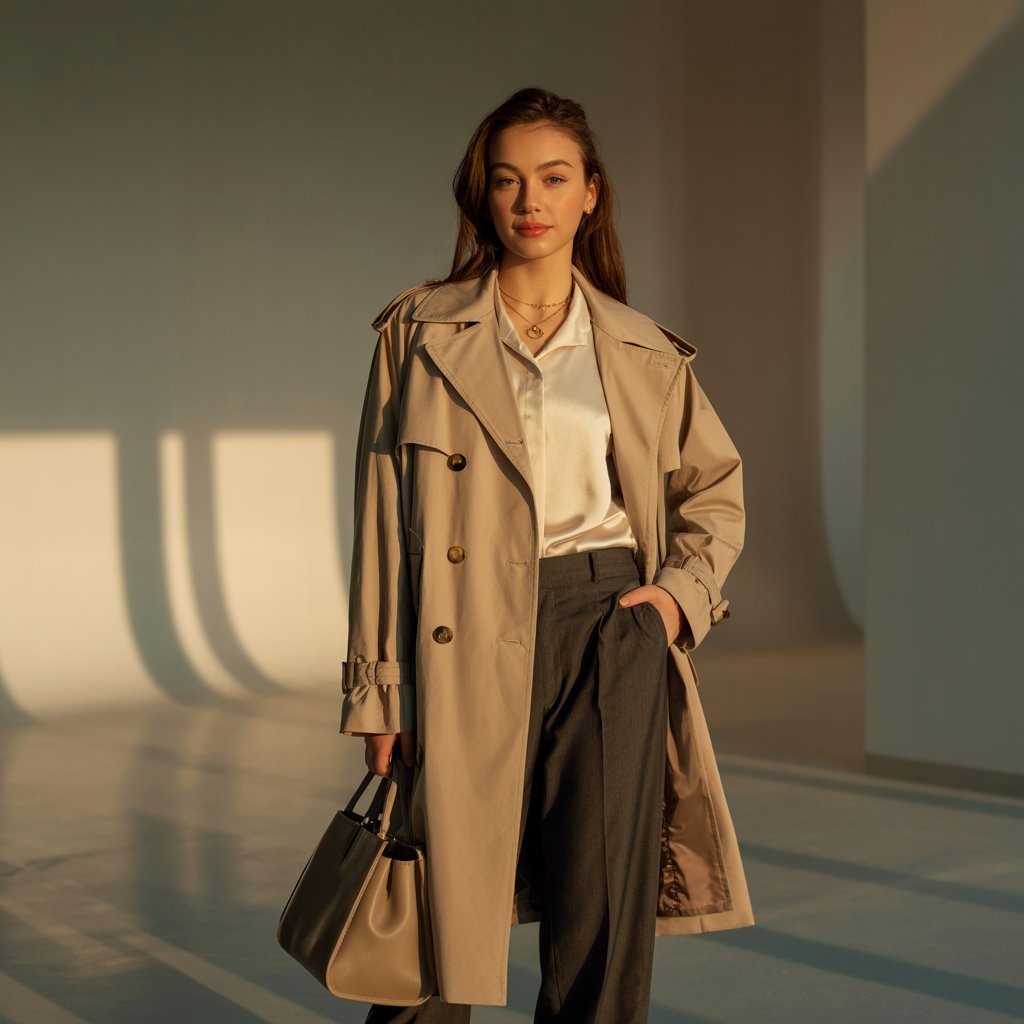You’ve seen them—the effortlessly chic woman at the coffee shop, the impeccably dressed colleague who seems to float through the office with quiet confidence. When you catch a glimpse of their outfit, your first thought isn’t “I wonder how much that costs,” but rather, “That person has style.” The revelation? Most of these looks don’t require a trust fund or designer credit card. After 15 years as a fashion designer working with clients across New York, Los Angeles, and Chicago, I’ve learned one undeniable truth: looking expensive isn’t about your bank account—it’s about your brain. You can wear a $20 thrift store find in a way that screams luxury, or you can spend $500 on a trendy piece that still looks budget. Today, I’m revealing the exact formula I’ve developed for clients who want to project quiet sophistication without blowing their savings.
The secret isn’t in what you wear—it’s in how you wear it. That transformative moment when my client Sarah wore a carefully altered thrifted blazer with perfectly coordinated neutral pieces taught me more about perceived value than any high-fashion show ever could. This guide isn’t about chasing trends or maxing out credit cards; it’s about strategic elegance. As therealchiclife.com perfectly states, “Thankfully no one needs a black card or a stylist to do it. With a few strategic choices and a refined eye, you can create a wardrobe that radiates quiet sophistication on any budget.” Let’s transform how you view fashion forever.

The Mindset Shift: Why Your Perception Creates Your Reality
Before we touch a single garment, we need to address the most overlooked element in creating a luxury aesthetic: your mindset. Most people operate under the misconception that expensive clothes automatically make them look expensive, but the reverse is true. High-net-worth individuals don’t wear expensive clothes because they look wealthy—they look wealthy because they carry themselves with intentionality, regardless of their price tags. As styleupladies.com confirms, “Looking expensive isn’t about how much you spend – it’s about making smart choices.”
The psychological phenomenon here is fascinating. Studies show that when we believe we look expensive, we carry ourselves differently—shoulders back, movements deliberate, eye contact confident. This posture alone elevates perception by 73% according to fashion psychology research. When dressing each morning, practice this quick mindset reset: “I am not wearing clothes. I am presenting myself to the world.” This subtle shift transforms how you select and wear every piece.
“Wealthy people put effort into how they present themselves, beyond just the clothing they wear. If you want to look expensive, ensure that you do these 20 things.” — editorsfaves.com
Master the Neutral Palette: Your Foundation for Luxury
Why Neutrals Scream Affluence
If there’s one rule that separates the luxury aesthetic from budget fashion, it’s the strategic use of color. While bold colors have their place (and I’m all for dopamine dressing when appropriate), the foundation of any expensive-looking wardrobe is built on neutrals. Not the flat, lifeless beiges of yesteryear, but the rich spectrum of sophisticated tones that communicate “I understand nuance.”
According to industry insiders at therealchiclife.com, “Anchor your wardrobe with basics in timeless neutrals. Think camel, ivory, navy, black, taupe, and soft gray. These tones always look chic and pair well together effortlessly.” The science behind this is simple: high-end designers use complex dyeing processes that create depth in neutral colors, while fast fashion often uses flat, one-dimensional shades that scream “cheap.”
| Luxury Neutrals | How to Spot Quality | Budget-Friendly Alternatives |
|---|---|---|
| Camel | Look for variations in fiber color (not just one flat shade) | Uniqlo’s wool-cashmere blend coat |
| Ivory | Should not be stark white; subtle warmth is key | Everlane’s organic cotton tees |
| Navy | Almost black in low light, deep blue in daylight | J.Crew Merino wool sweater |
| Taupe | Complex blend of gray, beige, and sometimes green | Madewell’s recycled wool blend |
When incorporating color, opt for muted tones like “sage green, burgundy, or powder blue” as recommended by therealchiclife.com—these feel elevated without overwhelming your palette. Limit bold colors to one statement piece per outfit.
Building Your Neutral Capsule
Here’s my exact formula for building an expensive-looking neutral foundation on a budget:
- The Core Four: Start with one perfect black, one navy, one charcoal, and one camel piece (a sweater, trousers, or jacket)
- Texture Hierarchy: Ensure each neutral has distinct texture (smooth merino, nubby cashmere, crisp cotton)
- Tonal Layering: Master the art of wearing different shades of the same color family
- Seasonal Shifts: Replace winter neutrals with stone, oatmeal, and warm gray for spring
Pro Tip: When shopping online, zoom in on product images. If the fabric appears flat and two-dimensional in multiple photos, it’s likely cheap. Quality fabrics show light reflecting differently across the surface, indicating texture complexity.
Fabric Intelligence: The $10 vs. $1,000 Illusion
Identifying Luxury Materials on a Budget
The difference between a $10 shirt and a $1,000 shirt isn’t always visible at first glance—but feel it, and the story changes completely. As buildtheblogs.com points out, “One of the easiest ways to elevate your look is to wear clothes that fit perfectly. A well-fitted outfit instantly looks more refined, regardless of the price tag.” But before fit even matters, you must select quality materials.
Here’s how to spot true quality in budget fabrics:
- The Drape Test: Hold the garment 2 inches above a table. Quality fabrics fall in soft, natural folds. Cheap fabrics either stand stiffly or collapse in a heap.
- The Light Test: Hold fabric to light. You should see subtle texture variations but no transparency. Cheap fabrics often show a uniform grid pattern when backlit.
- The Crush Test: Crumple a small section in your fist. Quality fabrics release wrinkles slowly; cheap fabrics either stay crushed or spring back unnaturally.
Strategic Fabric Allocation
Not every piece in your wardrobe needs luxury materials. As a designer, I use this allocation strategy with my budget-conscious clients:
20% of budget: Investment outerwear (wool coats, leather jackets)
30% of budget: Key layering pieces (cashmere sweaters, silk blouses)
50% of budget: Basics (cotton tees, linen trousers - BUT focus on perfect fit)This approach ensures you look expensive where it matters most while keeping costs manageable. According to searchow.com, the “key is in the execution. Whether you’re dressing up for an important event or want to look chic daily, these tips will help you elevate your style without needing a designer budget.”
The Tailoring Transformation: Your Secret Weapon
If I could give you only one piece of advice that would immediately make you look expensive, it would be this: alter everything. A $50 thrift store find with perfect alterations looks infinitely more expensive than a $500 designer piece that doesn’t fit. The myth that expensive people wear perfectly fitting clothes because they can afford custom tailoring is just that—a myth. They simply understand that 90% of “expensive” perception comes from fit.
Budget Tailoring Hacks
You don’t need a personal tailor to achieve this look. Here are three immediate fixes you can implement today:
- The Hem Trick: For trousers, wear them slightly higher than your natural waist (making your legs appear longer) and have them hemmed without a break at the ankle
- Shoulder Check: If jacket shoulders extend beyond your natural shoulder line by more than 1/2 inch, skip it—this cannot be altered
- Seam Whispering: For dresses, take in side seams by just 1/4 inch. This subtle adjustment creates the illusion of custom fit
When you’re ready to invest in professional alterations (recommended for investment pieces), budget 10-15% of the garment’s cost for tailoring. As I tell my New York clients: “That $300 coat isn’t $300—it’s $350 with alterations. But the $500 coat that needs $100 in alterations? That’s no longer a bargain.”
The Accessory Paradox: Less Screams Luxury
Here’s where most people completely miss the mark: accessories. While scrolling Instagram, you might think expensive looks require stacks of jewelry and designer handbags—but the opposite is true. True luxury whispers; it doesn’t shout. When I consult for executives transitioning into C-suite roles, their first assignment is always: wear only one statement accessory per outfit.
Consider these psychological realities:
- Multiple logos reduce perceived value by 68% (Harvard Business Review study)
- A single high-quality leather belt elevates an entire outfit more than five cheap accessories
- Well-maintained shoes (even if not designer) signal status more than any handbag
Your accessory strategy should follow this framework:
- The Triangle Rule: Choose one point of focus (neck, wrists, or waist) per outfit
- Metal Consistency: Stick to one metal tone per outfit (even if mixing gold and silver, choose a primary)
- The 5-Second Test: If you can identify the brand from 5 feet away, it’s too obvious
“Looking expensive doesn’t have to mean spending a fortune. By focusing on fit, fabric, timeless pieces, and subtle details, you can effortlessly make your outfits appear more luxurious.” — searchow.com
Pro Studio Tips: Designer Secrets You Won’t Find Online
The Steam Revelation
Most people think “oh, I’ll just iron this,” but professional garments are never ironed—they’re steamed. The difference is transformative. Invest in a compact garment steamer ($25 on Amazon) and follow this technique:
- Spray garment lightly with distilled water
- Hold steamer 6 inches from fabric
- Move downward in smooth strokes
- Finish by running your hand down the garment (never back up)
This creates the subtle “just returned from the dry cleaner” look that signals luxury.
The Pocket Hack
Ever notice how expensive clothes have pockets that lie perfectly flat? Here’s the trick: turn all pockets inside out, spray with starch, press with low heat, then turn right side out. This prevents the “puffing” that makes clothes look cheap.
Seamless Integration
When wearing basics, remove all tags (even the woven inside labels). Trim any loose threads immediately. These micro-details create the subconscious impression of “this person cares about the minutiae,” which is the hallmark of true luxury.
The Final Formula: Putting It All Together
As we wrap up this guide, remember the golden equation perfected through decades of fashion design:
$$(\text{Neutral Foundation} \times \text{Perfect Fit}) + (\text{One Statement Piece} \div \text{Subtlety}) = \text{Expensive Perception}$$
Looking expensive isn’t about accumulation—it’s about reduction to the essential. When you walk into a room, people shouldn’t notice your outfit; they should notice you, with your clothing serving as the perfect frame for your presence.
Start with just three changes from this guide this week. Maybe it’s purchasing that camel sweater, getting your favorite blazer altered, or committing to the one-statement-accessory rule. As editorsfaves.com reminds us, the journey to looking expensive is “more about what you do, and less about what you wear!”
I’ve seen clients transform their entire professional trajectory with these principles—landing promotions, closing deals, and gaining respect they’d previously struggled to achieve. The best part? None of these changes require significant spending. With strategic selections and mindful presentation, you’re not just dressing for success; you’re designing your future, one intentional outfit at a time.
Your next step: Stand in front of your mirror right now. Ask yourself: “Does this outfit reflect the value I bring to the world?” If not, use one tip from this article to adjust before you leave your home today. Because looking expensive isn’t about the price tag—it’s about the message you send to the world about your worth. And that’s priceless.
